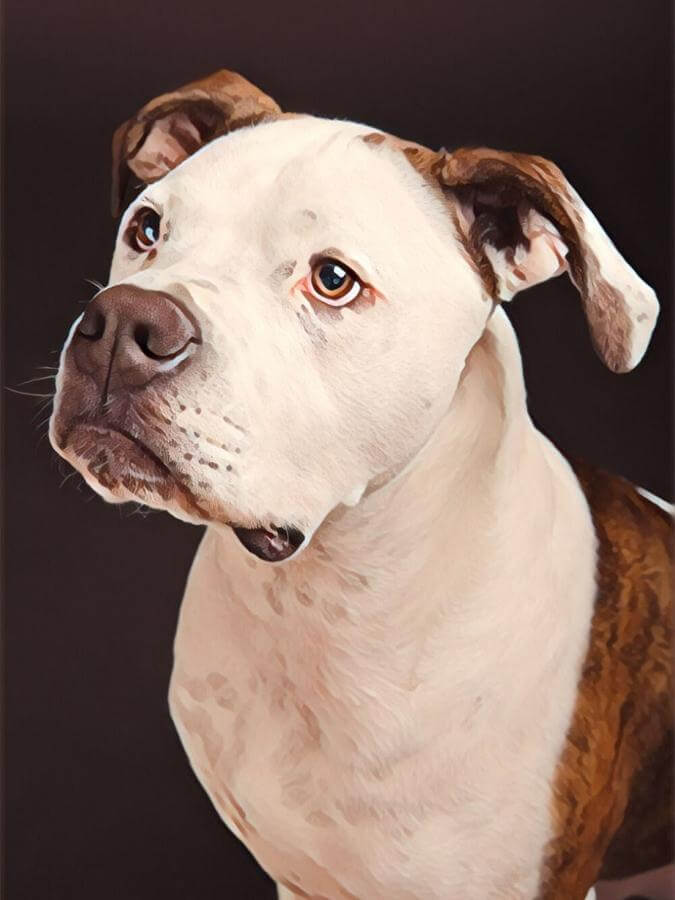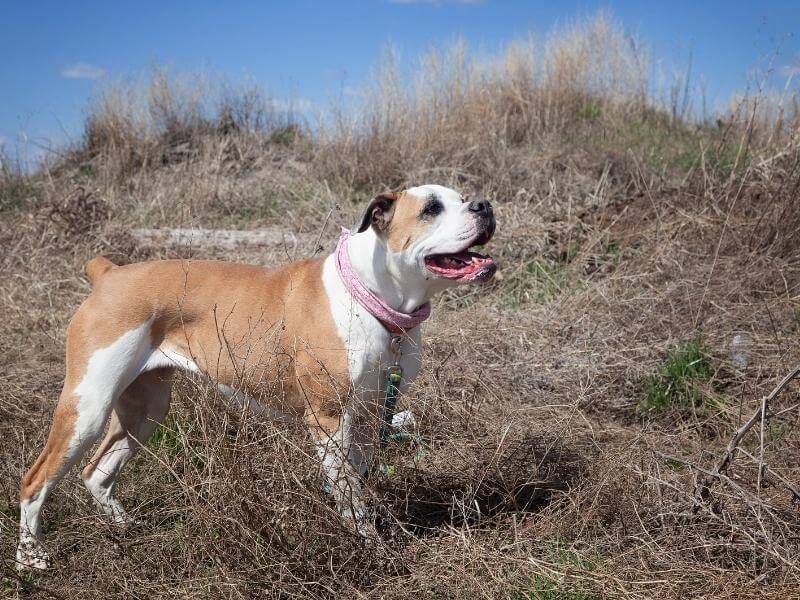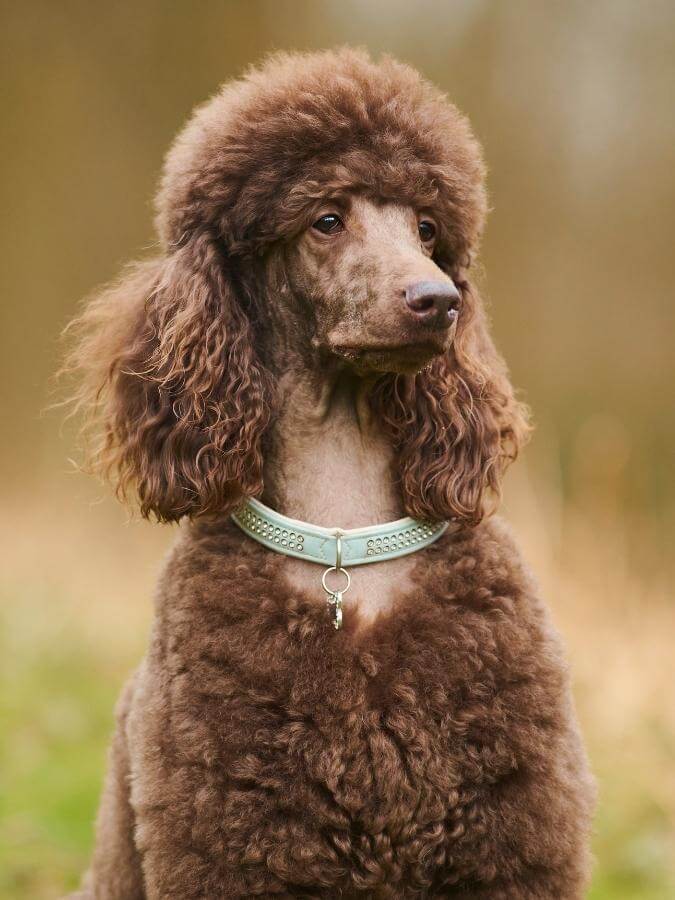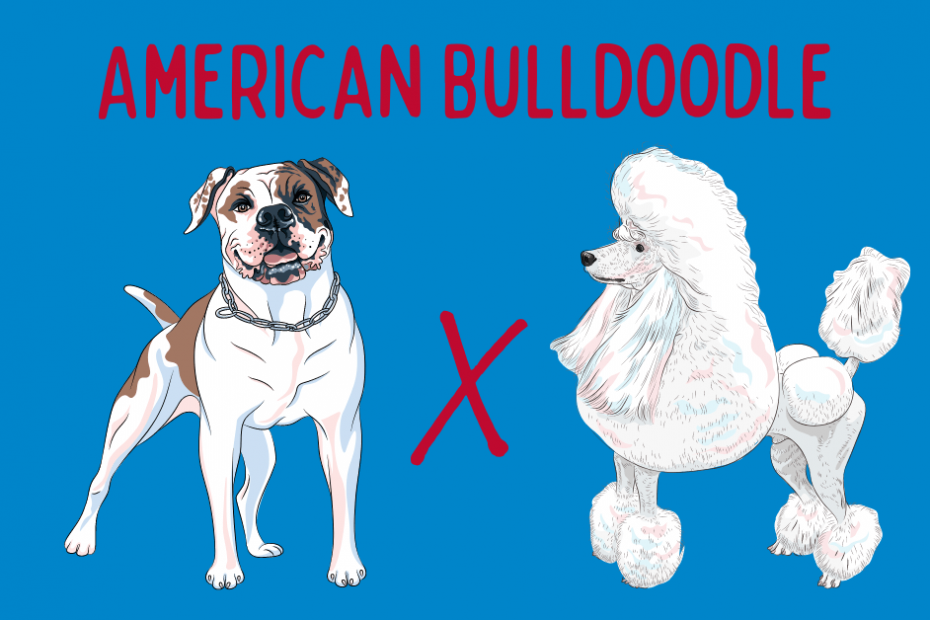What do you get when you cross an American Bulldog with a Poodle? You get the American Bulldoodle!
The vastly different traits of the parent breeds average each other out in this unique cross. The American Bulldog-Poodle mix has a relatively mellow temperament and is easy to get along with.
Is the American Bulldoodle the right dog for you? Keep reading to find out!
What is an American Bulldoodle?
An American Bulldoodle is a mix of an American Bulldog and a Poodle.
This Doodle breed is also sometimes known as an American Boodle. Offspring from crossing an American Bulldog and a Poodle results in a family-friendly, energetic dog and an overall great companion.
Read on to learn more about the American Bulldog and Poodle breeds.
History of the Parent Breeds
The following is a look at the traits of both breeds to help you get an idea of what you can expect from a combination of the two.
American Bulldog

The American Bulldog is a breed that was developed from the English Bulldog, and it’s possible that the bulldog arrived in America in the 1600s. However, the breed didn’t take hold in the U.S. until the 1800s with the mass immigration of farmers who brought their bulldogs with them.
The bulldog gets its name from the fact that it’s tough, solid, and capable of handling cattle and other livestock and game while listening to the direction of its owner.
Depending on lineage, the American Bulldog is a high-energy breed that requires regular stimulation and exercise to satisfy its need for engagement or a mellow character that’s happy to snooze all day long.
Owners of American Bulldogs love that their dogs can go out hunting, help bring down game, or work the farm, then come home and lie quietly in front of the fireplace. These dogs are also content to be playthings for children and are protective without being aggressive.
They also make excellent guard dogs. The American Bulldogs are a loyal and loving breed that brings delight to their owners.
American Bulldogs are a heavily muscled breed, which means proper nutrition is essential to help them stay healthy and strong. All dogs are omnivores, but some require a high-protein diet, while others do well on a varied diet.
Feeding a diet that’s almost meat is ideal for helping the American Bulldog stay healthy, maintain muscle mass, stay lean, and minimize the potential for gas.

The physical characteristics of the American Bulldog are different from its English counterpart due to the separation from the original bloodlines.
An English Bulldog tends to have short legs and a pugnacious appearance, commonly referred to as a fireplug physique. There are two main types of American Bulldog with some variations thereof.
The Johnson American Bulldog is close in appearance to the English variety but has longer legs and tends to be a little taller and more slender than its English counterpart.
In contrast, the Scott or Standard American Bulldog is taller, sleeker, and has a longer muzzle by and large. All boxers are classified as a brachycephalic breed due to their short muzzles and pushed-in faces.
Johnson American Bulldog
The Johnson American Bulldog is built like a brick house with broad shoulders and stance, powerful hindquarters, a thick, muscular body, and a boxy head with a short muzzle. They frequently have an underbite that thrusts their lower jaw out and allows their lower teeth to show.
You’d be excused for thinking that this lineage is directly descended from the English Bulldog due to the physical similarities, but the Johnson was developed after WWII.
Johnson American Bulldog owners love the breed for their low-maintenance needs. Individuals from this lineage tend to be low-energy and amenable to lying around the house until it’s time for a walk.
They like to get up and go now and again, but their default mental state is that of a mellow, pleasant dog. Providing a Johnson bulldog with regular exercise is a good idea to avoid obesity and keep the joints mobile.
Scott American Bulldog
The Scott American Bulldog lineage is the opposite of the Johnson regarding physique and energy levels. Scotts are taller and leaner in build. They are also higher in energy.
They’re frequently confused with Mastiffs due to their similar appearance. Owners of Scott bulldogs say that their dogs need to be trained as soon as they’re old enough to learn the word “no.” Otherwise, they can be more challenging to train as they age.
Poodle

The Poodle has a reputation for being a frou-frou breed due to its popularity among the wealthy. They’re frequently viewed as dogs with no other purpose apart from ornamentation, but this perception couldn’t be further from the truth.
The Poodle was initially developed as a hunting and water dog with the stamina and speed to go after the game or collect it. Dogs that exhibited silky and curly coats were selected for breeding as it was easier to groom and maintain.
The modern Poodle retains many of its hunting traits in that they’re intelligent and attentive but can be stubborn and opinionated. The breed isn’t necessarily high energy, and it’s happy to relax with the family when it’s time.
However, a Poodle needs regular exercise to burn off its energy and help it stay in shape. They also need frequent brushing to keep their hair coat in good condition and regular visits to the groomer to keep their coats manageable.
Appearance of the American Bulldoodle
The American Bulldog and Poodle have different physiques, coat types, heights, and mental traits, but they work well as a hybrid despite their physiological differences. Offspring from the combination of a Poodle with an American Bulldoodle tend to combine features of both parents or favor one over the other.
One of the main reasons why Poodles are crossed with other breeds is to bring together desirable traits, including the hypoallergenic coat that the Poodle is famous for. However, the hypoallergenic attribute doesn’t always come through.
Coat type
The most common coat type is a curly coat with fine hair, although it tends to be shorter and denser.
Coat colors
Coat colors vary greatly because an American Bulldog can exhibit multiple colors and patterns. In contrast, the Poodle’s primary colors are fawn, peach, cream, chocolate, and black, with the occasional red or chestnut coat. No one coat color dominates among hybrid offspring.
Size of the American Bulldoodle
The adult size of an American Bulldoodle depends on the parents’ size.
Poodles range in size from miniature to standard, while the Johnson American Bulldog reaches as high as 28 inches at the shoulder. The Scott American Bulldog reaches about 24 inches in height.
The average size and weight for a cross between a Johnson American Bulldog and Standard Poodle are:
Height
Males – 25 inches
Females – 21 inches
Weight
Males – 100 pounds
Females – 80 pounds
The Poodle tends to “lighten” up the physique of the American Bulldog, with offspring showing a more slender body that’s heavier than the Poodle but lighter than the American Bulldog.
Traits and Characteristics

Personality of the American Bulldoodle
The fact that the American Bulldoodle is a hybrid and doesn’t have decades of selective breeding to normalize its traits. However, both breeds are known for their good nature and willingness to be faithful companions.
The American Bulldog tends to be harder to train, but the Poodle’s smarts can help temper the stubbornness of the American Bulldog.
Both are active breeds that need regular exercise, but an offspring that has the stamina of the American Bulldog needs a different type of workout than one that takes after the speed of the Poodle.
Both breeds are people-oriented and do well with other animals in the household. Their offspring carry these traits as well. While the American Bulldoodle isn’t a nanny dog, they do like children and play well with them as a general rule.
High-energy individuals are great for families with young children that are prepared to play with their dogs and wear them down.
After a day of play, everyone comes home to relax with each other as the night winds down. Both breeds act as guard dogs and don’t hesitate to tell off an intruder, but they don’t offer aggression if their owners welcome someone to the house or property.
The American Kennel Club rates the American Bulldog as moderate for being good with other dogs and children and high for affection towards family. The Standard Poodle gets high marks for being affectionate with family and young children. It scores moderately for being good with other dogs.
American Bulldoodle Health Issues
Purebred dogs tend to have genetic health issues due to a lack of hybrid vigor and selective breeding. Good breeders do their best to eliminate these issues, but it’s not always avoidable.
Crossing the Poodle with the American Bulldog can result in hybrid vigor that overcomes these issues, although it’s not guaranteed. The common health issues of both breeds may show up in the offspring and include:
- Hip dysplasia
- Epilepsy
- Retinal atrophy
- Hypoglycemia
- Thyroid issues
- Addison’s disease
- Bloat
- Collapsed trachea
- Ear infections
- Skin conditions
- Neuronal ceroid lipouscinosis
- Ichthyosis
- Kidney disorders
- ACL tears
- Cherry eye
- Entropion
- Ectropion
- Bone cancer
A reputable breeder will disclose the potential for any of these issues in the offspring of affected parents.
Average Lifespan
The American Bulldoodle can live anywhere from 10 to 15 years old.
Final Thoughts
The American Bulldoodle brings together two breeds that don’t share much in common regarding physical and personality traits.
However, this isn’t a reason to overlook or dismiss the hybrid, as a good breeder can combine two parents that work well together to produce puppies that deliver the best of both breeds.
The American Bulldoodle is best suited for families or individuals who want a dog that can keep up the pace and be active without high energy. It’s a designer breed made for doing a job and getting it done right.


